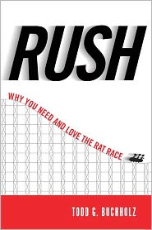 Excerpt
from Rush: Why You Need and Love the Rat Race
Excerpt
from Rush: Why You Need and Love the Rat Race
by Todd G. Buchholz
As Interest Rates Fall, Civilizations Rise
As an economist, the best measure of time I can find is the prevailing interest rate. When interest rates are high, it tells us that tomorrow counts for less. It is not worth investing today. From a business point of view, very few financed projects will payoff if interest rates are high (the "hurdle rate"). However, when interest rates are low, it tells us that we should invest today because any return will be prized more in the future. During the German hyperinflation of the early 1920s, prices and interest rates jumped higher each hour. The price of a cup of coffee could go up as the waitress was pouring. Teachers got paid at ten a.m. and brought their banknotes to the playground so their relatives could pick them up and then buy things immediately. Likewise, the hyperinflation of Zimbabwe in recent years acted like a neutron bomb on the economy. Coincidentally, in 1919, when Yeats wrote "things fall apart; the centre cannot hold," interest rates were jumping sharply, the British pound slid in value, and Europe was preparing for a terrible bout of post-World War I inflation. Elsewhere, I set out "the Buchholz Hypothesis," arguing that the crime rate is importantly a function of interest rates. This solves the puzzle of the Great Depression. Most commentators on crime say that a lousy economy leads to crime. But during the Great Depression, crime rates fell, as they did in 2008 and 2009. Why? Because interest rates fell, too. People did not give up on tomorrow, even as they suffered economic distress.
If you charted interest rates over the past two thousand years, you'd mostly see a decline. Certainly the advent of banks and enforceable legal contracts have played a huge role. Mostly, though, interest rates have declined because life has become more secure (thanks, in part, to contracts). If your shop looks like it will catch fire tomorrow because bandits will come pillaging through town, lenders will not trust that you will pay them back.
Simply comparing interest rates from Bronze Age Sumer to ancient Greece shows a sharp drop, from 20 percent to 10 percent. From ancient Greek civilization through the ancient Roman civilization rates declined a bit further. Historians have uncovered the accounts of the Temple at Delos from the second century BC. The temple took in money through offerings from pilgrims and from visiting monarchs from Macedon, Egypt, and Pergamum. The temple did not have a modern vault; it kept the funds in jars, and then lent them out to property buyers. For a five-year mortgage, the temple would charge 10 percent. In case of default, the temple could seize the property of the borrower, according to a well-defined contract. Medieval Europe enjoyed falling rates from about AD 1250 to roughly the time of Darwin. Shakespeare would have gotten better terms than Chaucer, and Dickens better terms than Shakespeare. Ironically, Shakespeare set the bitter moneylending of The Merchant of Venice in Italy, where interest rates dipped to nearly half of English levels. Bassanio would have gotten worse terms in London.
Competitive societies do a better job of setting interest rates than noncompetitive societies. Interest rates depend on a whole set of purely economic factors, such as inflation and the quantity of money in circulation. But they also rest on the competitive quest for credit. Businesses and entrepreneurs show up at the bank or at the bond market with their plans and spreadsheets, trying to persuade lenders that they have a better plan and prospect for profitability than everybody else. When a couple buying a new home applies for a mortgage they are (unknowingly) arguing that they are a better credit risk than alternative borrowers. A credit-rating system is a competitive system. Not everyone or every business presents the same credit risk. That's why IBM can borrow at 3 percent, but the MGM Mirage gaming and hotel company might issue a junk bond at 11 percent. In 2010, as Mediterranean governments shuddered with bankruptcy fears, Greece had to pay 20 percent for money it promised to repay in two years, while Germany could sell ten-year bonds at just 2.5 percent. That's why you might loan $5,000 to your neighbor and not even $100 to your nephew carrying the skateboard under his arm. If we cut out the competition for credit -- if we made sure everyone could borrow on the same terms -- we'd punish the economy, discourage lending, and set back our hopes for progress in this world.
Regardless of specific differences in interest rates, this point stands: Societies that make tomorrow more appealing show more progress. And not just material, GDP-measured progress. They also show less bloodshed and longer lives. We all know the cliche used when we send an urgent package: "time is of the essence." Well, it turns out that time is of the essence of human progress. Either we imagine progress and move forward, or we sink into entropy and the center does not hold.
The above is an excerpt from the book Rush:Why You Need and Love the Rat Race by Todd G. Buchholz. The above excerpt is a digitally scanned reproduction of text from print. Although this excerpt has been proofread, occasional errors may appear due to the scanning process. Please refer to the finished book for accuracy.
Copyright © 2011 Todd G. Buchholz, author of Rush: Why You Need and Love the Rat Race
